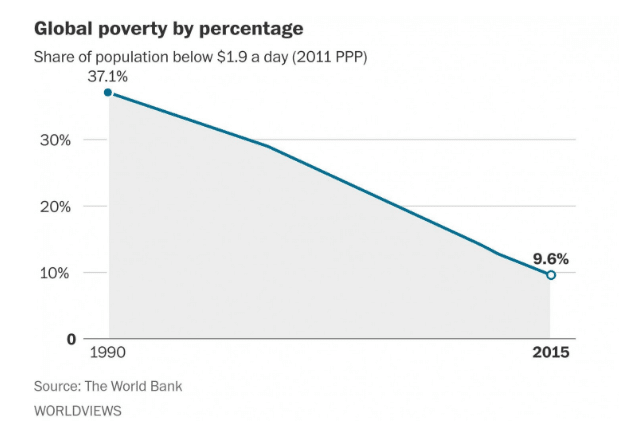In October 2015, for the first time ever, the World Bank estimated that the global rate of people living in extreme poverty (calculated as people living on less than $1.90 per day) fell to just under than ten percent. Consider this—in 1990, there were approximately 5.2 billion people on the planet, 37 percent of whom were living in extreme poverty. Today, there are more than seven billion people on the planet, less than ten person of whom are living on less than $1.90 per day. In many ways that is simply astounding, and almost unbelievable. I mean, how were we able to achieve such progress in just a couple of decades? When I began to unpack that question and try to understand the causal mechanisms behind the reduction in poverty, what I found gave me cause for concern. For instance, while more than a billion people have “escaped” poverty, their present-day vulnerabilities are still stark. This is important because the celebration of their escape from extreme poverty has created a mirage that disguises their daily sufferings.
Image via Washington Post
The present-day vulnerabilities of many
Even though the rate of extreme poverty has declined to less than ten percent, escaping extreme poverty is not enough because billions of people are still living vulnerable lives. In sub-Saharan Africa, for instance, the percentage of people living on less than $3.10 a day, another World Bank measure of progress, stands at 67 percent; globally, it is 30 percent. Living on $3 a day does not prevent many of the ills and perils that are certain to befall this segment of the population, as many still have little to no access to quality education, health care services, social security, and permanent employment. So, while progress has been made, prosperity has not been achieved. And anything short of achieving prosperity creates a slippery slope in which many can slide back quickly to extreme poverty.
Programs that truly create prosperity should be the standard towards which countries and development organizations aspire. The importance of this point cannot be overstated because simply lifting people above poverty leaves them in precarious, and sometimes deadly circumstances.
The real reason so many escaped poverty
China, a country that never showed much interest in the Millennium Development Goals (MDG)—a set of targets put forth by the United Nations in 2000 with the goal of halving extreme party by 2015— achieved all of the MDGs. In fact, between 1980 and 2015, China pulled more than 800 million people out of extreme poverty, reducing its poverty rate from 88 percent to around four percent. In contrast, even though the extreme poverty rate in sub-Saharan Africa reduced from 56 percent in 1990 to 43 percent in 2012, the region has added more than 50 million more people into this group. The number of people living in extreme poverty today in sub-Saharan Africa is more than 330 million.
A careful assessment of the decline in global extreme poverty rates then shows that China and its reforms have been responsible for a majority of it. The question we ask to better understand how to propel other nations from poverty to prosperity, then, is, how did China do it?
China, like some of its neighbors such as South Korea, Taiwan, and Singapore, invested in innovation. China effectively became a major manufacturer of products that many people in the world demanded. For instance, in 1985, China exported $3.8 billion worth of goods to the United States, but by 2015, China’s exports to the United States reached $483 billion, representing an increase in exports of more than 12,610 percent. And the United States was not the only country where China exported its products. China’s ability to develop products that catered to the global nonconsumption market is what is behind the reduction in global extreme poverty rates.
How to move forward
While progress in alleviating overall poverty should be celebrated, it behooves us to try to understand the reason for that progress and how to expedite the process in countries that find themselves in more precarious circumstances today. As such, our research at the Clayton Christensen Institute for Disruptive Innovation takes a different approach than conventional methods do in trying to understand the causal drivers of prosperity.
Instead of looking at wealthy countries today, we have analyzed wealthy countries when they were poor and have identified that investments in disruptive innovations that are targeted at nonconsumption cause economies to traverse from poverty to prosperity. We are developing tools, frameworks, and models that will help investors, entrepreneurs, and policy makers implement better decisions as they seek to create prosperity for themselves and for their countries. Will you join us?




